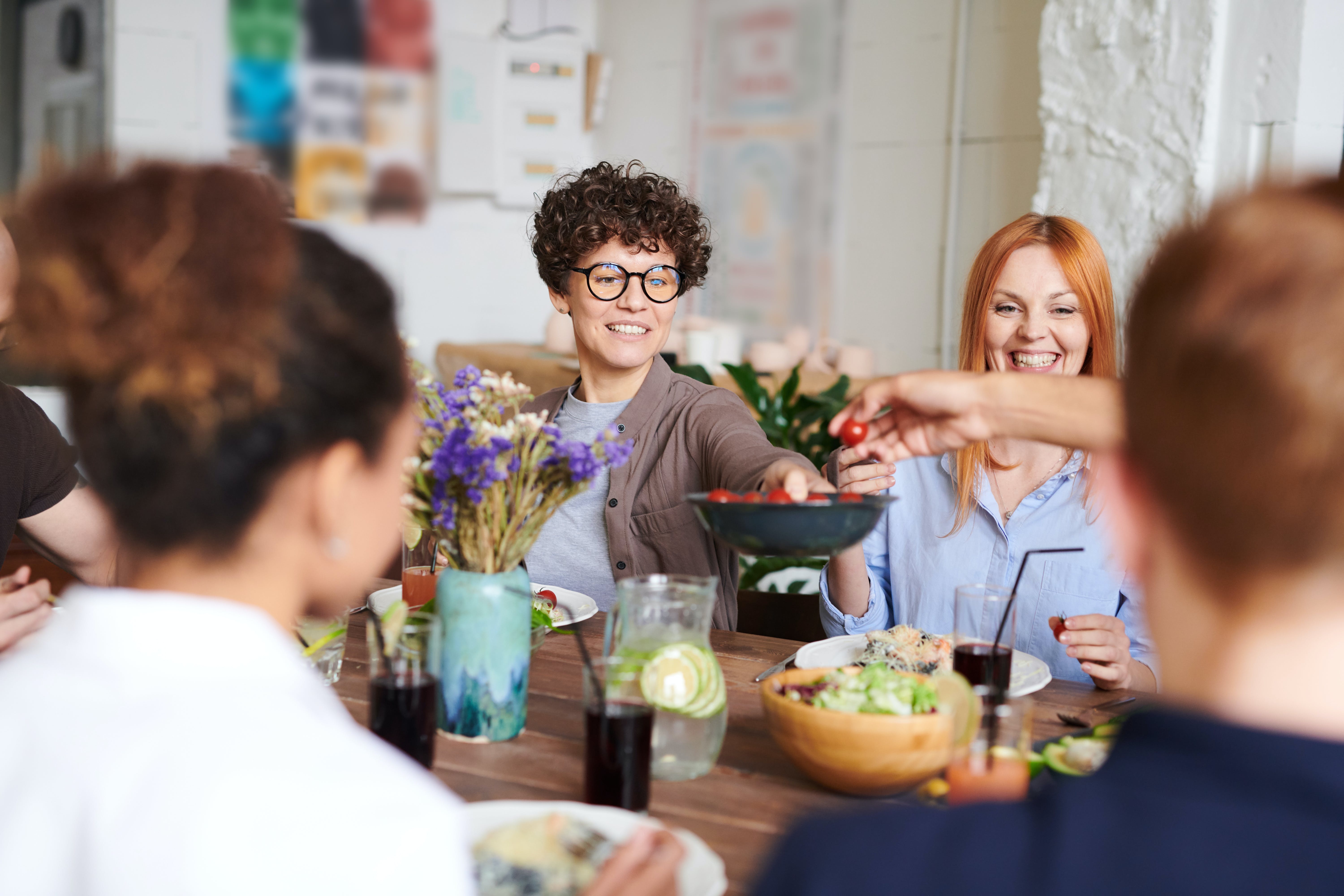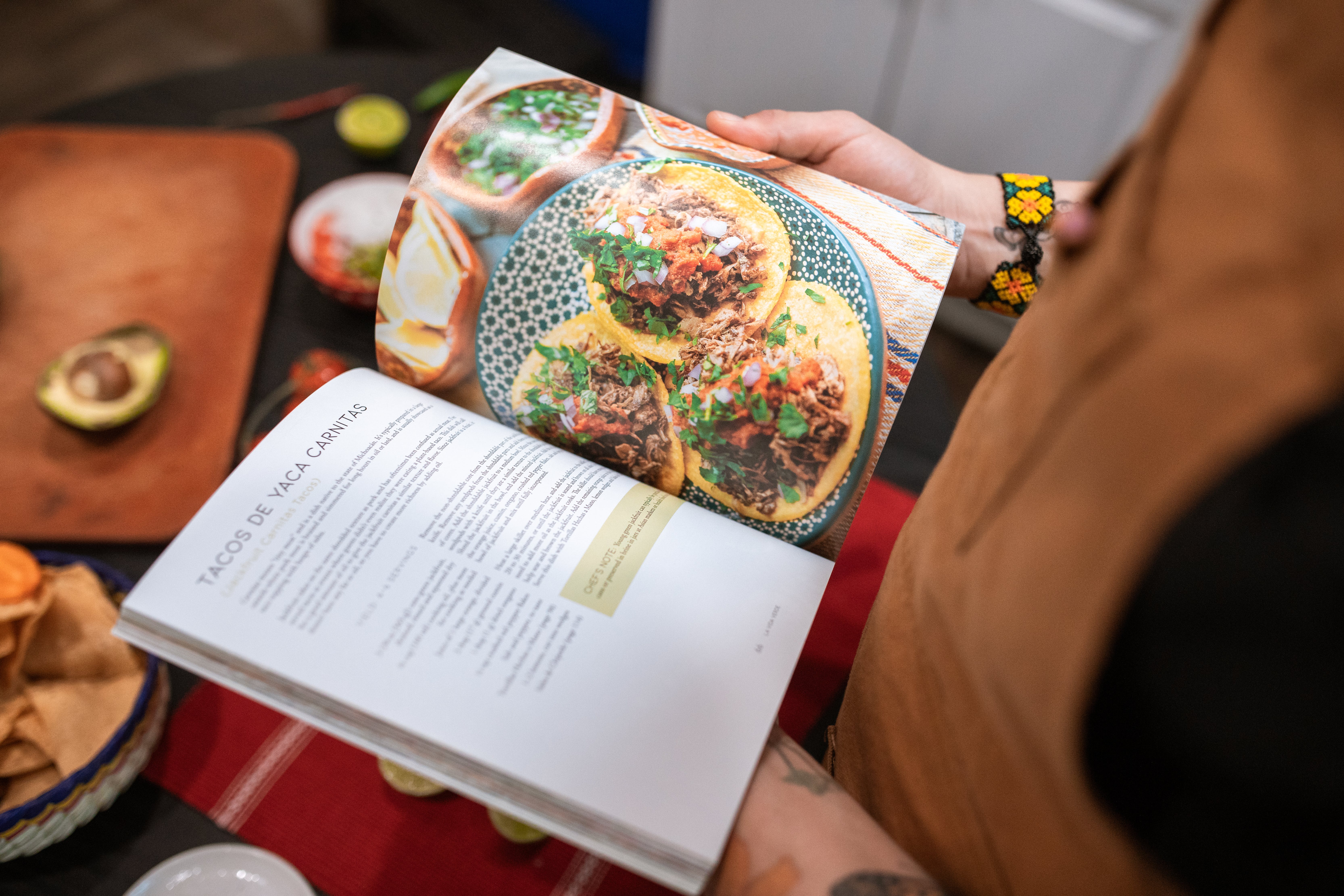If you enjoy trying new recipes and sharing good food with friends, then starting or joining a cookbook club is for you.
A cookbook club is a group of people who get together regularly to cook and share dishes from the same cookbook. It’s like a book club, but with food. It’s a fun and rewarding way to try out new cookbooks, explore different cuisines, improve your cooking skills, and bond with your fellow foodies.
In this ultimate guide, we’ll cover everything you need to know about cookbook clubs, including how to start a cookbook club and how to run one. We’ll also give you some tips and tricks on how to enjoy your cookbook club meetings and learn from them. And lastly, we’ll walk through how Bookclubs can help you organize your cookbook club.
So grab your apron and your appetite, and let’s dive into the world of cookbook and recipe book clubs!
What is a Cookbook Club?
A cookbook club comprises a group of food-loving people who meet regularly to cook recipes from a chosen cookbook and discuss their cooking experiences together.
Typically, each meeting is dedicated to a different cookbook. Each club member chooses a different recipe to prepare and share at the meeting.
It's a social way for home cooks to try new dishes, cooking techniques, and global flavors that they might not normally prepare for everyday family meals.
What are the benefits of a Cookbook Club?
There are many benefits to starting or joining a cookbook club:
- Lower stress than a dinner party. Instead of cooking a whole meal, cook just one to two dishes yet still enjoy an epic, multi-course feast.
- Make new friends or strengthen existing relationships. A cookbook club lets you connect over a love of cooking, eating, and exploring new flavors. These friendships can extend well beyond just the club meetings.
- Expand your recipe repertoire. Cookbook clubs expose members to an array of recipes beyond the standard rotation. You can explore new dishes, and even new cuisines and cultures.
- Improve your cooking skills and confidence. You'll gain cooking knowledge and experience making recipes you may have never attempted before. You may be challenged by new techniques – but the good part is that you’ll have fellow cooks to back you up, whether you need to ask for advice, borrow tools, or get input on ingredient swaps.
- Try before you buy. At a cookbook club meeting, you’ll get to taste a wide array of recipes from the cookbook, which will help you decide if it’s worth investing in the cookbook for further use. You’ll also get to hear from other members about their experience following the recipe, to determine if the cookbook’s recipes are well written and well tested or not.
- Have fun and satisfy your taste buds. What could be better than spending time with like-minded people and eating delicious food?
How to Start a Cookbook Club
Starting a cookbook club is not as hard as you might think. You just need to make some basic decisions and invite some people who share your passion for cooking and reading. Follow this roadmap to launch a cookbook club.
Recruit a Core Group of Passionate Members
Start with a small group of engaged recruits who share a zeal for cooking and will reliably participate. Foodie friends, cooking classmates, coworkers, neighbors, and family members make great candidates. The ideal number of members varies based on several factors including how dedicated people are (will they show up to every meeting?) and the size of your venue. Typically somewhere between 4 and 12 people is a good number to start with.
Having trouble finding people? Try listing your club on social media, or on Bookclubs’ Join a Club page.
Set a Regular Meeting Schedule
Decide how frequently your club will meet - monthly, quarterly, etc. Monthly meetings allow enough time in between for members to fit club activities into busy schedules.
Pro tip: set a consistent date, like the 1st Wednesday evening of each month, so that members can easily put cookbook club on the calendar. You’ll typically want to set aside at least two hours to give time for both eating and discussion.
Decide on Your Hosting Location
Rotate meetings between members' homes to share hosting duties. Some clubs also reserve space in restaurants, community centers, or cooking schools. My cookbook club makes cooking a dish optional if you’re hosting, given the cleaning duties you’ll need to take on!
Draft Guidelines
Decide how your club will choose cookbooks, assign dishes, distribute recipes if not everyone owns the book, navigate dietary needs, and run discussions. Draft clear guidelines so member expectations are set.
Set Up a Communication Hub
Create a private Facebook group, group chat, or text thread to easily coordinate meetings, discuss recipes, and swap cooking tips in between meetups. Or even better, use Bookclubs, which is specifically designed to track and choose books and to coordinate your group.
How to Run a Cookbook Club
Choose your cookbook
You want to think through several factors when picking a cookbook, but how you weigh them may depend on the interests and goals of your members. For example, are your club members looking to expand their recipe collection when it comes to easy, everyday means or are they looking for inspiration for special occasions?
Here are some factors we consider in our cookbook choice:
- Theme, cuisine or style of the book (this could be a specific cuisine like Italian, Thai or Mexican; cooking methods like pressure cooking or grilling; celebrity chef authors; ingredients spotlights like herbs or chocolate; or dietary needs like gluten-free or vegan)
- Level of difficulty and accessibility of the recipes (Is the book suitable for beginners or does it require advanced techniques?)
- The availability and affordability of ingredients (Do the recipes use standard ingredients found in the average grocery store, or will members need to seek out specialty shops?)
- The reviews and ratings of the book (highly-rated books often have well-tested recipes)
When it comes to actually picking the book, you can try one of several strategies. You can let one person decide (for example, if you rotate hosting duties you could have the host choose the cookbook for their meeting). You can come to a group consensus (easier with a smaller group). Or you can vote and let the majority decide! We recommend Bookclubs’ free book polling feature for easy voting - we especially love being able to see the cookbook cover in the poll!
Once you’ve decided on a book, the club members can buy it or check it out from the library. If people aren’t quite ready to purchase, members of my club who already own the book will share photos of the recipe list and then a photo of the chosen recipe. Hopefully you love the recipes and can then decide to purchase the cookbook and support its author after your meeting!
Choose your recipes
Each member should sign up to cook one or two recipes. You can use a shared spreadsheet or Bookclubs potluck poll tool to track who is cooking what. Most clubs use a first come, first served method - whoever signs up first gets first dibs on recipe selection! A few considerations to keep in mind:
- Balance the types of dishes chosen to comprise a complete meal with appetizers, main dishes, sides, desserts and drinks
- For variety, avoid choosing recipes with duplicative main ingredients or flavors
- If necessary, make sure there are sufficient dishes that accommodate allergies or dietary restrictions
Prepare your space to host a cookbook club meeting
-
Prepare cards for each dish with the name of the recipe and the name of the member that cooked it (you can do this ahead of time or just leave out paper and pens – folded over index cards work great for this!). You can also include dietary information such as allergens (e.g., “contains nuts”, “gluten-free”)
- Have enough plates, cups, eating utensils and napkins for all attendees. Determine if you need bowls and spoons based on the dishes being prepared.
- Don’t forget about serving utensils! If you don’t have enough, ask members to bring one for their dish
- Determine where you want people to set up. Will you serve the meal family style with dishes on the table? Or do you want a buffet and if so, where?
- Ensure adequate seating. If you have provided disposable plates and utensils, ensure there’s a trashcan nearby for easy cleanup.
- Provide water at a minimum, and other drinks if you desire.
- Think through reheating options if needed (including using a microwave or preheating your oven).
Enjoy the meeting!
The most important part of your meeting is trying each of the dishes and enjoying your meal! In addition to chowing down, you can also participate in the following cookbook club activities:
- Have a group discussion about the cookbook, the recipes, and your cooking process. Did you find the recipe easy to follow? Did you have to make any tweaks or substitutions? How did the recipe compare to others you’ve tried?
- Take photos to memorialize your meal! (If you use Bookclubs, you can store them in a club photo album for each meeting)
- Vote for your favorite dish - depending on the size of your club you can each go around the table and share your favorite, or you can set up a voting station. My club uses a bulletin board and at the end of the meal we pin up the cards that identify all the dishes. Each member then puts an additional pin or sticker on their favorite.
- Some clubs also choose to decide on the next meetings theme or even browse cookbook options at the end of each meeting.
Cookbook club etiquette
If you come with an open mind and an empty stomach, you’ll probably be a good cookbook club member! But here are my top five cookbook club etiquette tips:
- Much like a dinner party, arrive on time! You don’t want everyone’s dishes to get cold while they wait for you.
- Offer to help with setup and especially cleanup.
- Be respectful and appreciative of the host and other members, who all put effort into preparing the meal.
- Note any significant substitutions or issues.
- Enjoy the food and the company!

How to Use Bookclubs to Organize Your Cookbook Club
Throughout every step of the process, Bookclubs can help keep your cooking club organized so you can focus on cooking, eating and enjoying instead of on logistics and administration!
Here are some of the many ways you can use Bookclubs to organize your cookbook club:
- Pick a date: Use Bookclubs’ polling feature to figure out the best date and time for your club to meet.
- Track all the books you want to cook: Keep a running list of cookbooks that your club is interested in cooking from on your club’s “Books We’d Like to Read” bookshelf. Any member can recommend a book to the club and include a note on why they’d like to cook from it.
- Let the people decide: Use Bookclubs’ book polls to vote on which cookbook you’ll tackle next.
- Sign up for individual recipes: Use our Potluck feature to sign up for which recipe each member is preparing for the next meeting. You can add categories (appetizer, main, dessert, etc.) if you want to make sure the entire meal is covered.
- Never forget an upcoming cookbook club meeting: Schedule your meeting on Bookclubs and we’ll send you automated reminders before your meeting. You can even set up your club to sync meetings with your personal calendar.
- Add new members with a snap: want to add a new member to your club? No need to get everyone to update the latest email thread. Just send the newest member an email or text invite to your club and they’ll automatically be added to distribution lists and be able to see your upcoming meetings.
- Revisit the hits: easily look back to see the cookbooks your club has tried in the past, as well as any ratings or reviews from members if they have added them (our bookshelves and polls include the cover images of the book as a handy visual reminder of which book was which.)
- Archive your memories: Create photo albums to create a record of all your beautiful dishes!
Create a free club today to try out Bookclubs for your cookbook club or upgrade your club to take advantage of even more organizational tools.
Conclusion
Cookbook clubs are a great way to combine your love for cooking and reading. They can help you improve your cooking skills, expand your culinary horizons, and connect with your friends over delicious food and engaging conversations.
We hope this guide has inspired you to join or start your own cookbook club. If you have any questions or feedback, please let us know in the comments section below. We would love to hear from you.
Thank you for reading and happy cooking! 😊




